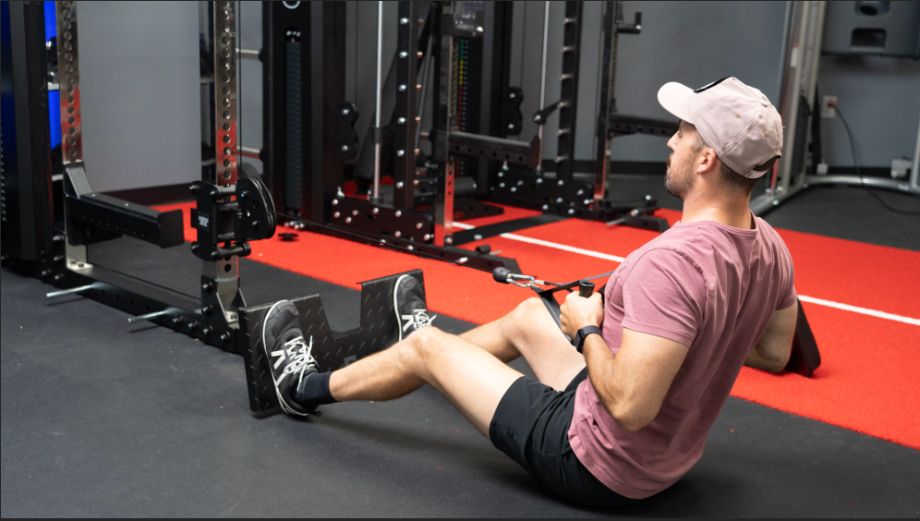We test and review fitness products based on an independent, multi-point methodology. If you use our links to purchase something, we may earn a commission. Read our disclosures.
Safe. Versatile. Efficient.
You may be wondering why I’m listing these seemingly random words. Well, there’s a reason. These are just some of the benefits of working out on a piece of gym equipment that can sometimes get overlooked. That’s correct—the cable machines.
We appreciate that you may already know or do one or two cable exercises, such as the cable fly or cable tricep pushdown. But, contrary to popular belief, you can get a full-body workout using the cables only. If done properly, you’ll still be able to build strength and muscle, similar to traditional resistance training using free weights.
RELATED: How to Build Muscle
As a certified personal trainer (CPT), I’m here to show you how. I’ll start by explaining the benefits of training with cable machines, then go into the best cable machine exercises. To finish, I’ll even give you some tips on how to make the most of your cable machine workouts.
Why Train With Cable Machines?
So, you’re intrigued. But maybe you’re still skeptical and don’t think cable machines are as good for building as free weights. I’ve been there. Before you make that decision, read this section. I also consulted with certified personal trainer (CPT) and GGR Head of Content Kate Meier to get her thoughts.
RELATED: Best Cable Machines for Home Gyms
Here are three reasons why you should consider training with cable machines:
Safety
If you’re new to strength training or have had injuries that limit your mobility, cable machines are safer than barbells or dumbbells, especially for some exercises. Kate Meier, NASM-CPT, USAW-L1, CF-L1, says, “Doing flyes or tricep extensions with dumbbells puts a lot of stress on your joints, especially as you get older.”
Even if you’ve been lifting weights for a while, replacing free weight exercises with cables may help limit your risk of injury.
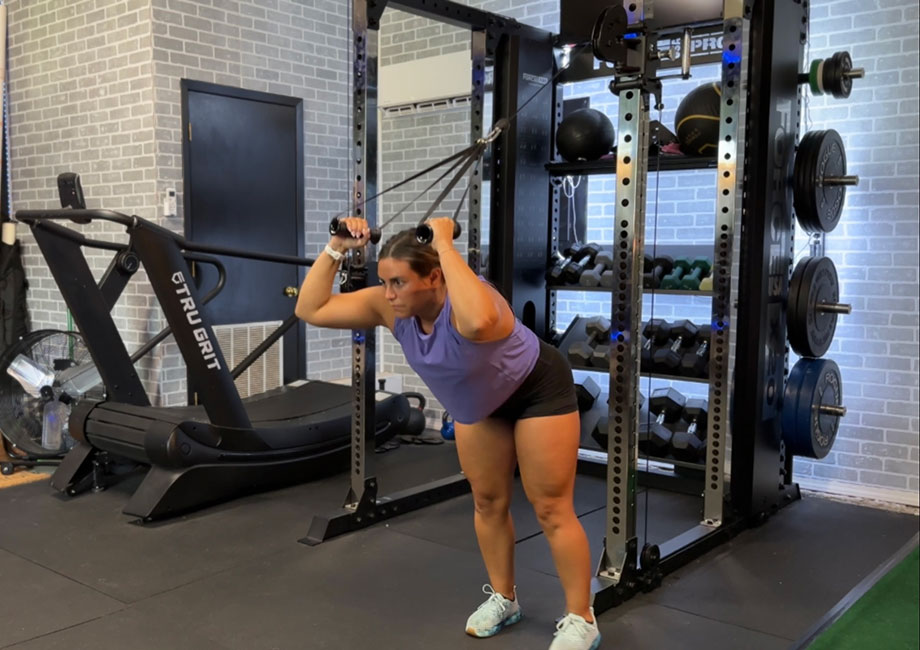
Versatility
With cables, you can easily change the attachment, your grip, or the positioning of the pulley to target a different area of the muscle group you’re working on. This makes the cables extremely versatile. Compared to selectorized weight training machines, with the cable machines, starting and ending joint angles may be better, and you may get a better range of motion (ROM), according to the Journal of Strength and Conditioning Research1.
More Efficient
Compound exercises using barbells or dumbbells are great, but they usually require long rest times in between sets. You may not want to superset them because you want your body to recover fully. When using cable machines, you usually need shorter rest periods and can do supersets or tri-sets to make your workout efficient.
“Cable machine workouts are great for when I’ve only got 30 minutes or so to exercise because I’m able to do five or six full-body exercises for three or four sets each,” Kate adds.
Best Cable Machine Exercises
Now that you’re completely sold on using cable machines for your next training session, see below for my 12 favorite cable machine workouts:
Cable Lat Pulldowns
Why do it: Lat pulldowns are one of the best exercises out there to strengthen and build muscle in the back. Lat pulldowns can also help you to get stronger at pull-ups.
How to do it:
- Position the pulley in its top position and attach a rope, straight bar, wide bar, or v-grip attachment, depending on the area of the back you’d like to target.
- Select the weight, then grab the attachment.
- Take a few steps backward, then hinge forward slightly at your hips if performing standing or sit down on the floor, mat, or bench if performing seated. If seated on the floor, you’ll want your legs extended with a slight bend in the knees.
- Leaning back slightly, bring the attachment down to your chest region. Focus on activating the lats rather than the biceps.
- Pause, then return the attachment to its original position.
- Pull down for the desired number of reps.
Muscles targeted: Latissimus dorsi, biceps, rear deltoids, rhomboids, traps
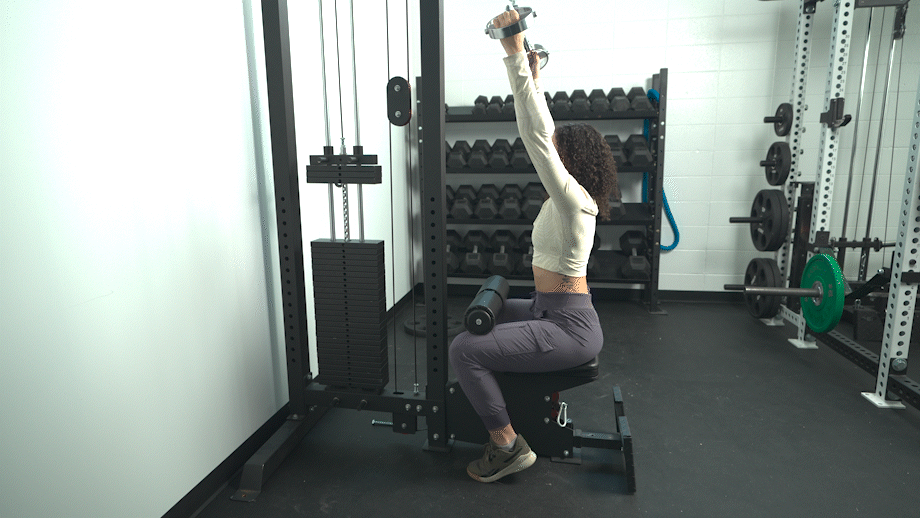
Cable Bicep Curl
Why do it: Kate Meier, NASM-CPT, USAW-L1, CF-L1, says, “Doing cable curls provides constant tension on the biceps throughout the whole range of motion.”
Although not as popular as bicep exercises using dumbbells or barbells, cable bicep curls came joint second in a 2014 study2 comparing muscle activation of the biceps during various exercises.
How to do it:
- Select your desired weight, then set the cable machine to the low pulley position.
- Attach a straight bar attachment to the pulley.
- Face the cable machine near the bar and take hold of it. You’ll want to use an underhand grip for the exercise (with your palms facing the ceiling).
- With your chest up and back straight, curl the bar towards your shoulders. Ensure you tuck your elbows in to stop them flaring outwards.
- Hold for a moment at the top, then return the bar back down in a controlled manner.
- Repeat for desired reps.
Muscles targeted: Biceps, forearms, deltoids
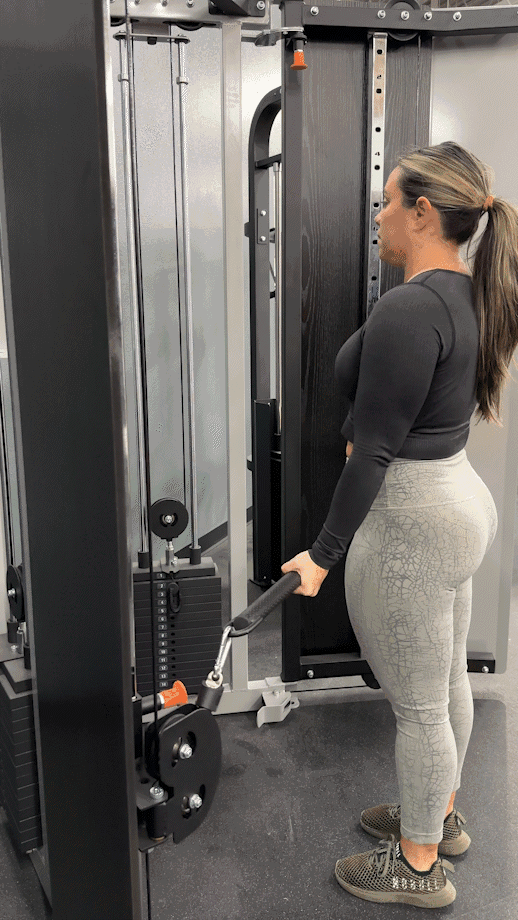
Cable Rope Triceps Extension
Why do it: With the cable rope triceps extension, you’ll build muscle in your triceps, which can help with other strength training exercises such as the barbell bench press and the overhead shoulder press.
RELATED: The Almighty Bench Press
How to do it:
- Attach a rope to the cable machine, adjusting the pulley to the top position.
- Pick your weight, then grab the rope using a neutral grip (with your palms facing each other).
- Looking away from the cables, take a few steps forward. Adjust your feet so they’re in a staggered position, one in front of the other.
- In the starting position, your hands should be resting slightly behind your head, and your elbows tucked in near your ears.
- Extend the elbows to straighten your arms.
- Pause before slowly returning the rope handle to the start.
- Continue for the desired number of repetitions.
Muscles targeted: Triceps
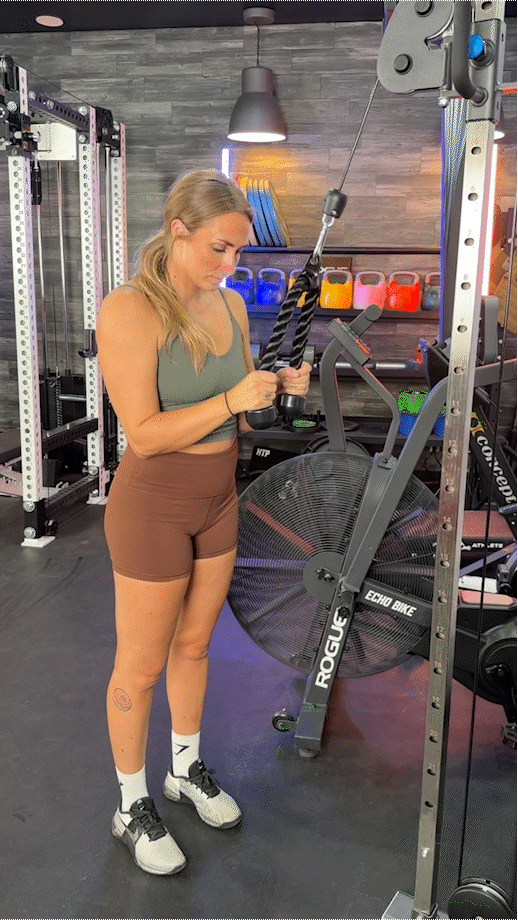
Seated Cable Rows
Why do it: Seated cable rows target various muscle groups in the upper body. “You’re rowing in a fixed range of motion with seated cable rows, which is safer for beginners and those who have injuries,” says Kate.
How to do it:
- Adjust the pulley system so it’s at chest height whether you’re seated on the floor or on a bench.
- Choose the appropriate attachment. The V-grip is the most popular, but you can use a straight bar or a wide bar, too.
- If seated on the floor, ensure there’s a slight bend in your knees. Place your heels against an aerobic stepper for more stability if you’d like.
- Take hold of the attachment by leaning forward. Keep your arms in an extended position.
- Stick your chest up, retract your shoulder blades, and row the attachment towards your abdominal region by bending at the elbows.
- Hold, then slowly straighten your arms.
- Row for reps.
Muscles targeted: Lats, trapezius, rear deltoids, biceps
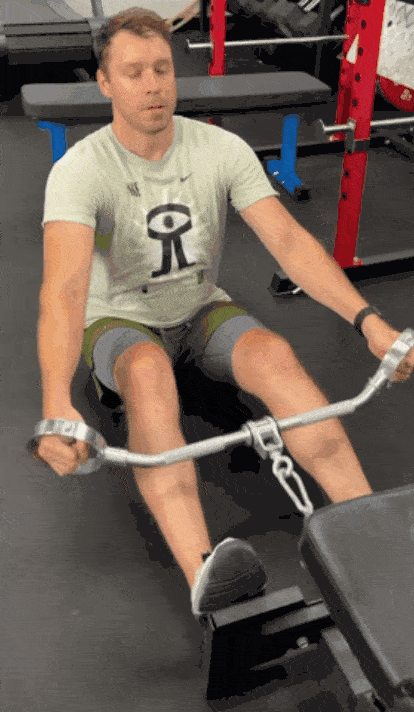
Cable Face Pulls
Why do it: Regularly doing face pulls can help improve your shoulder health and mobility because of the muscles it targets. They can also help improve your posture.
How to do it:
- Select your desired weight, then fix the pulley so it’s above head height. Add a rope attachment.
- Take hold of the rope with an overhand grip (with your palms facing the floor).
- Step away from the cables until your arms are straight, then position your feet shoulder-width apart.
- Activate your core and glutes, retract your shoulder blades, then pull the rope toward your forehead.
- Pause before straightening your arms to their original position.
- Repeat as required for reps.
Muscles Targeted: Rear delts, rhomboids, middle traps
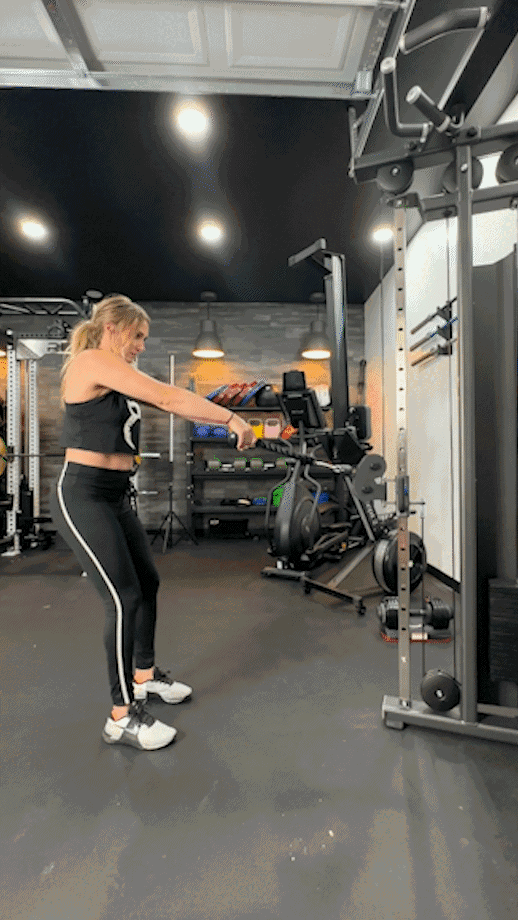
Cable Crossover
Why do it: Adding cable crossovers to your workout routine helps with hypertrophy of your chest and front delts. It’s similar to the cable fly but with an added range of motion.
How to do it:
- Set both sides of a cable machine to their highest position, then attach handles.
- Choose your weight (the same on both sides), then position yourself in the center. Take hold of the handles.
- Take a step or two forward, keeping your arms wide. This is to ensure you’re getting a stretch in your chest.
- While your head stays neutral, and with a slight bend in your elbows, bring the handles toward each other.
- Don’t stop in the middle as you would do with a cable fly (which you’ll see below), but continue the motion until one arm crosses the other.
- Hold, then reverse the motion in a controlled manner.
- Repeat for reps.
Muscles Targeted: Pecs, front deltoids, triceps, biceps
RELATED: Inner Chest Workout
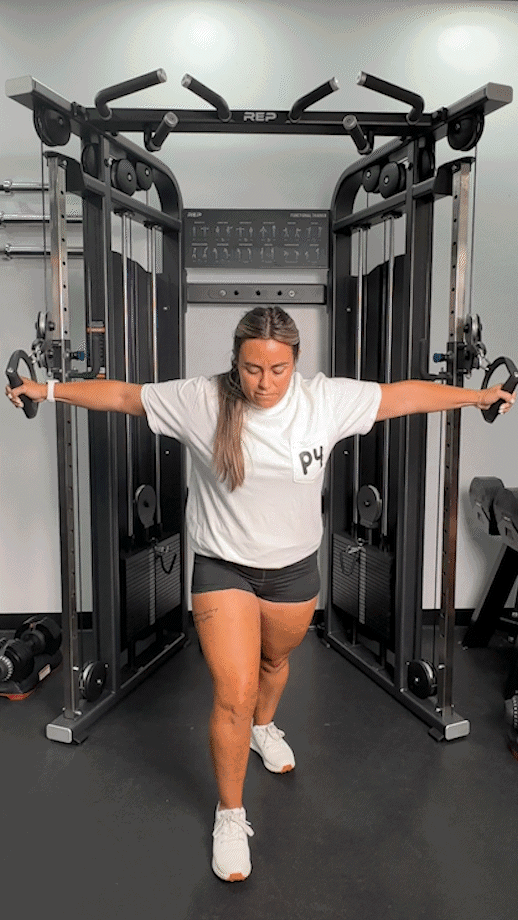
Cable Crunches
Why do it: “Cable crunches are one of my favorite exercises for the core,” Kate explains. “This is because there’s constant tension on the abs throughout the movement.”
How to do it:
- Place a rope attachment on one side of a cable machine, then adjust the pulley so it’s at shoulder height.
- Take hold of the attachment with a neutral grip, then get onto your knees, facing the weight stack. You may want to use an exercise mat here for added support for your knees.
- Position your hands so they’re by your forehead, one on either side.
- Keep your head neutral, engage your core, then crunch forward by bringing your elbows down toward your knees.
- Pause, then slowly go up to the starting position.
- Continue for the desired number of reps.
Muscles Targeted: Core muscles
RELATED: Cable Ab Workouts
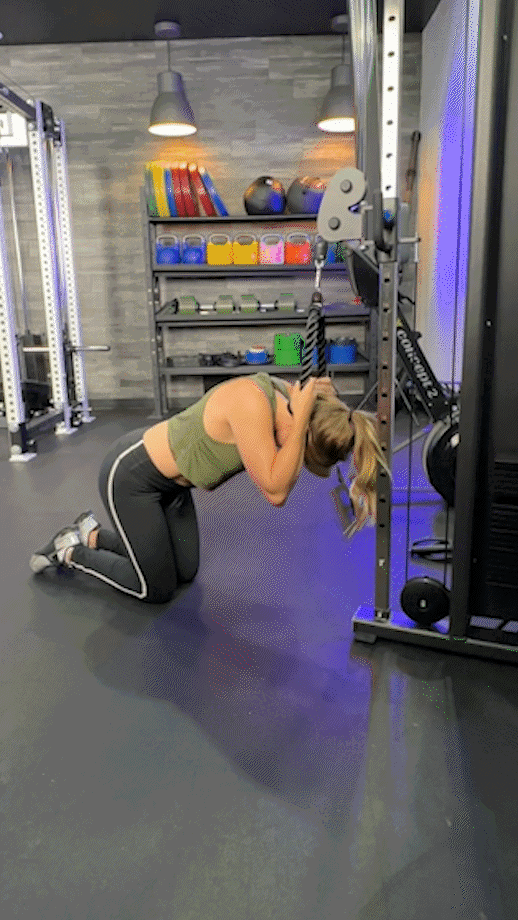
Cable Lateral Raise
Why do it: Because you train one side at a time, the cable lateral raise can help fix muscular imbalances in your shoulders. The lateral deltoids can be difficult to target, but this exercise isolates them well.
How to do it:
- Adjust the cable pulley to the bottom setting, then attach a handle to it.
- Grab the handle with your left hand, with your right shoulder closest to the weight stack. Position the handle around your pelvic region.
- Take a couple of steps away from the machine to create tension, then stand up tall with your chest up and core activated.
- Raise your left arm laterally until it aligns with your left shoulder. You’ll want a slight bend in your left elbow.
- Hold, then bring the handle back down slowly.
- Repeat for reps, then switch over to the right side.
Muscles Targeted: Deltoids
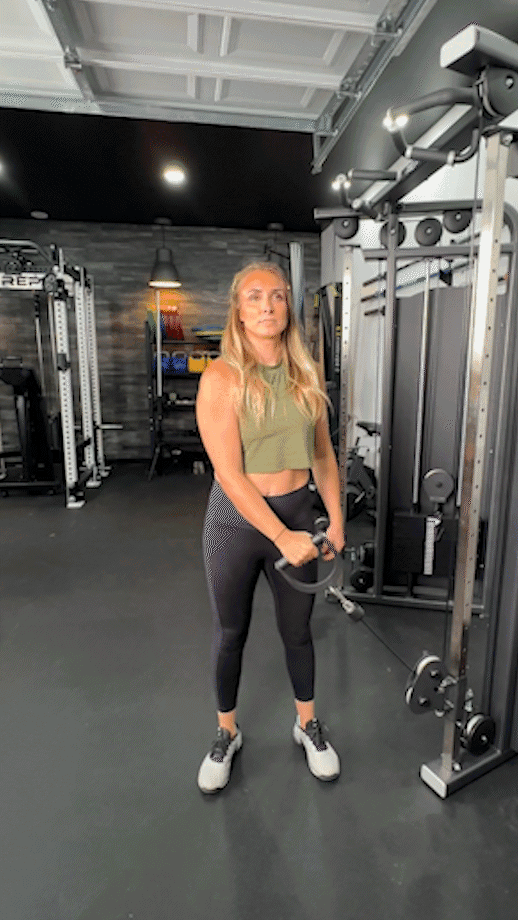
Cable Fly
Why do it: Standing cable flyes are an alternative to dumbbell chest flyes, and I like the fact that there is less stress on the joints with cables. You can also easily adjust the position of the pulley to target different areas of your chest.
How to do it:
- Put handle attachments on both sides of the cable machine, then adjust the pulleys so they’re at chest height. Select your desired weight.
- While keeping your arms wide, grab the handles.
- Take a couple of steps forward until you feel a stretch in your pecs and delts. Most people prefer doing the cable fly in a split stance, with one foot in front of the other.
- Pull the handles toward each other until they meet in front of your chest. Have a slight bend in your elbows here and make sure your head is neutral.
- Hold, then slowly return the handles to the starting position.
- Repeat for reps.
Muscles Targeted: Chest, delts, triceps
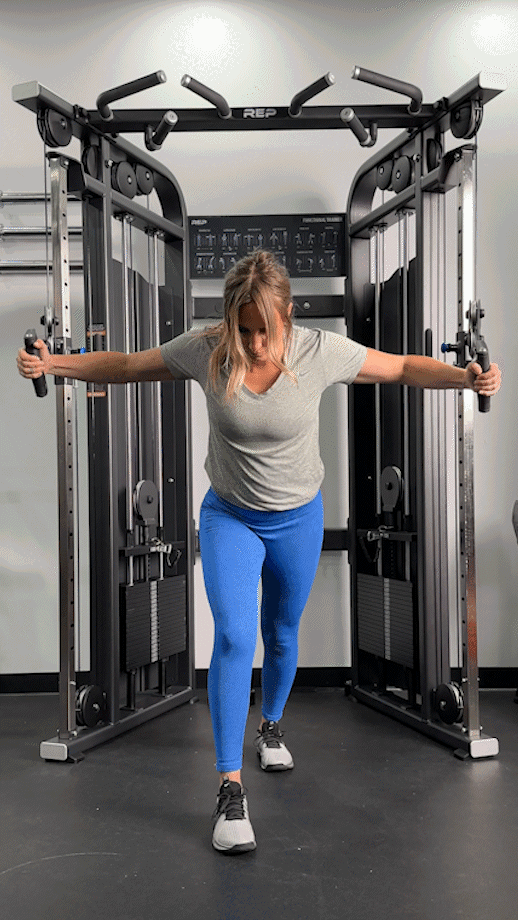
Cable Upright Row
Why do it: You’re able to increase muscle mass in your shoulders and other areas of your upper body with this exercise. There are lots of variations too (all you need to do is change the attachment!).
How to do it:
- Position the pulley at the bottom, then attach a rope or straight bar to it.
- Take hold of the attachment with an overhand grip (palms facing the floor), then stand up straight, facing the machine. Your arms should be extended.
- Take a one or two steps back to get into the starting position. Then, by bending at the elbows, pull the attachment toward your chin.
- Squeeze your delts and trapezius muscles at the top, then lower the attachment down.
- Continue for the desired number of reps.
Muscles Targeted: Delts, traps, biceps, triceps, upper back muscles
RELATED: Best Deltoid Exercises
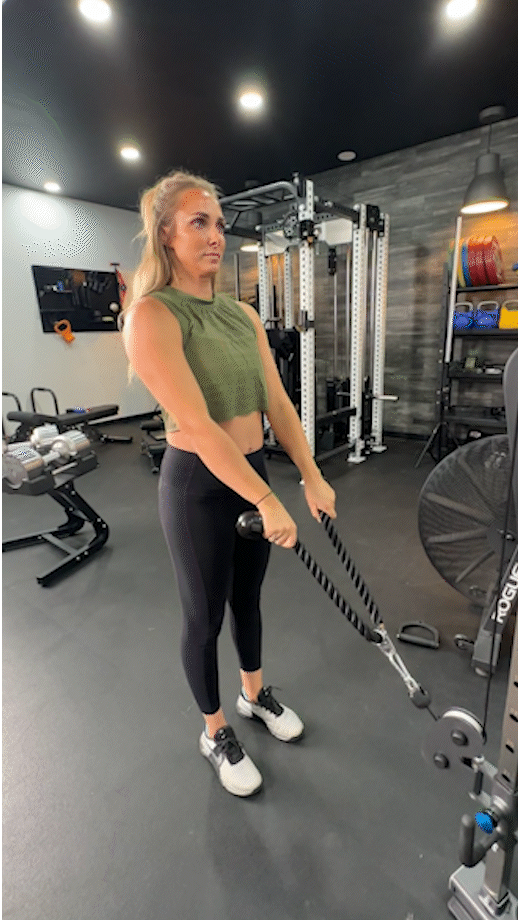
Cable Kickback
Why do it: “There are tons of benefits of strengthening the muscles in the lower body,” explains Kate. “For example, if you suffer from lower back pain or have poor posture, exercises such as cable kickbacks can make a huge difference.”
How to do it:
- Set one side of a cable machine to the lowest position, then fix an ankle strap attachment to it.
- Loop the ankle strap around your left ankle, then stand up facing the weight stack.
- Position both feet on the floor, about shoulder-width apart. Grab hold of the cable machine with both hands to help you with stability.
- With your left leg straight, raise it backward towards the ceiling. Your right foot should be firmly planted on the floor.
- Hold at the top, then slowly lower your left leg down.
- Kick back for reps, then switch over to the right leg.
Muscles Targeted: Glutes, hamstrings, calves
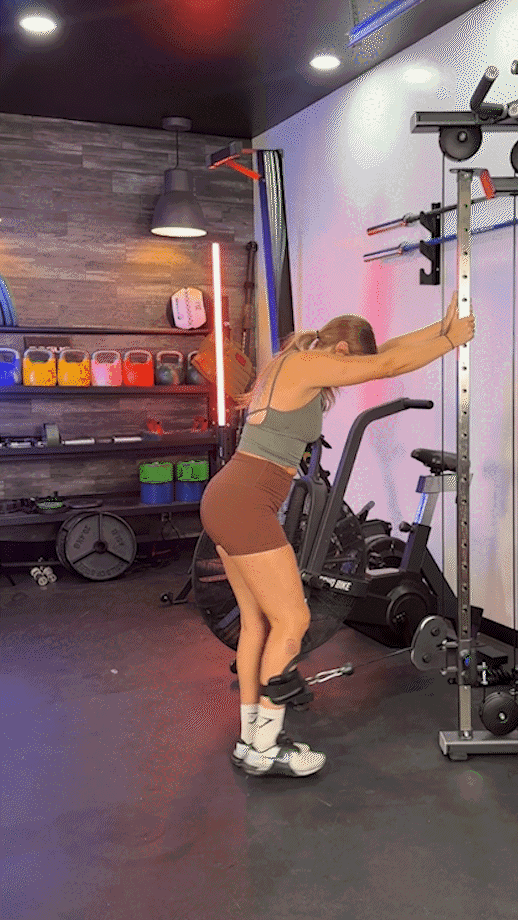
Cable Wood Chop
Why do it: The cable wood chop is a great addition to any cable machine workout because it improves hip and shoulder strength and mobility, while strengthening the core at the same time.
How to do it:
- Position the pulley so it aligns with your core, and fix a handle attachment.
- Stand with your left shoulder facing the cable machine. Grab the handle with both hands, one hand on top of the other.
- With your arms straight, take a couple of steps away from the machine until you feel tension. Then, engage your core and squeeze your glutes.
- By twisting the upper body only, move the handle from the left side of your body to the right side. Pause here.
- Bring the handle back to its original position in a controlled manner.
- Repeat the chopping motion for reps, then switch to the opposite side.
Muscles Targeted: Core, shoulders, obliques, hips
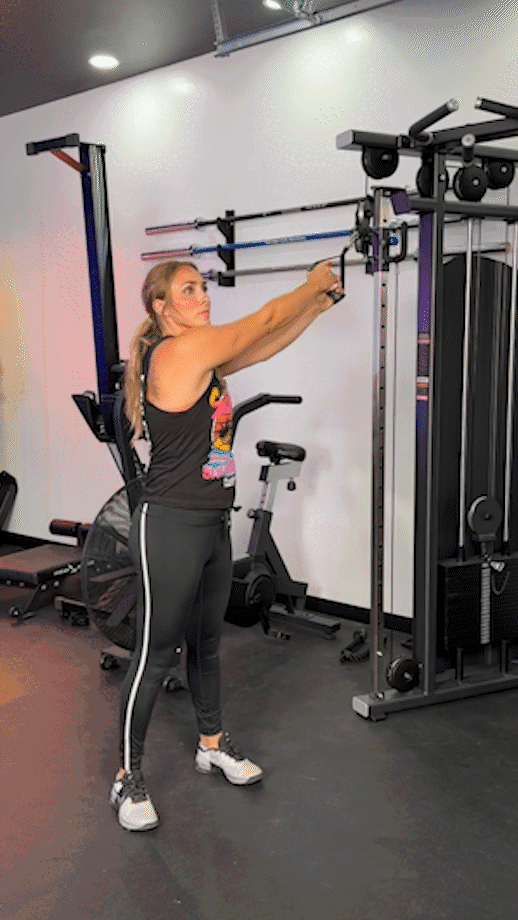
Cable Machine Workout Tips
Your next question is probably, ‘How can I make the most out of my cable machine workout?’
Here’s the part when you need to stop streaming your favorite TV show and pay attention. It depends on your goals. Someone looking to build muscle will need completely different sets, reps, and rest times compared to someone who’s looking to improve their muscular endurance or someone who’s focused on strength gains.
For strength increases, Sports (Basel)3 recommends you do one to five repetitions per set with heavy loads. To gain muscle (hypertrophy), aim for eight to 12 reps per set. For endurance, it’s 15 or more reps each set. Generally, muscular endurance needs the shortest rest times in between sets (around 30 to 60 seconds), followed by hypertrophy (one to two minutes), then strength (over two minutes).
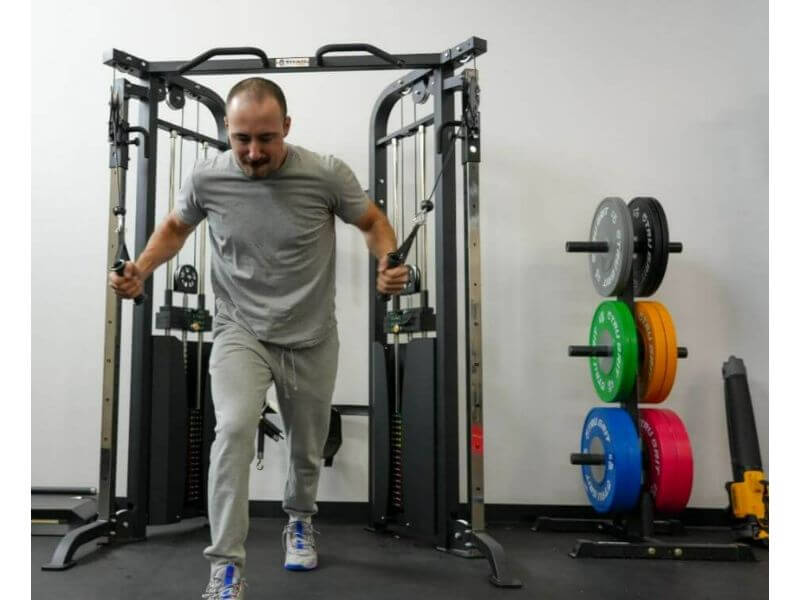
How many sets should you do on each exercise based on the goals above? That’s difficult to answer because it depends on how many total exercises you’re doing. I’d suggest doing a minimum of three sets of each exercise, regardless of your goals. “You could even do more than this because more volume generally gives you quicker results,” Kate adds.
Cable Machine Workouts: Final Thoughts
Although cable machines aren’t as popular as free weights, they offer many benefits for your workouts. Cable machines are safer, more versatile, and can give you a more time-efficient exercise session.
To review, here are the 12 best cable machine workouts for you to try:
- Cable Lat Pulldowns
- Cable Bicep Curl
- Cable Rope Triceps Extension
- Seated Cable Rows
- Cable Face Pulls
- Cable Crossover
- Cable Crunches
- Cable Lateral Raise
- Cable Fly
- Cable Upright Row
- Cable Kickback
- Cable Wood Chop
Cable Machine Workouts: FAQs
Is a cable machine a good workout?
Yes, you can get a good workout using a cable machine due to the constant resistance on your muscles. There are also many benefits to using the cables over barbells and dumbbells—they’re safer, more versatile, and usually more time efficient.
What workouts can you do at a cable machine?
You’re able to train your entire body on a cable machine. For the upper body, try exercises such as cable flyes, cable lat pulldowns, cable biceps curls, seated cable rows, cable rope triceps extensions, cable upright rows, cable face pulls, cable crossovers, and cable lateral raises. As for core and lower body work, try cable kickbacks, cable crunches, and cable wood chops.
Can I build muscle just with a cable machine?
It’s possible to build muscle using just a cable machine. When doing any cable exercise, there’s constant tension on that muscle group because of how the machine is designed. What does this mean for you? Yep, muscle growth. You’re also able to isolate smaller muscle groups better when using a cable machine, some of which get overlooked during traditional weight training.
RELATED: Best Supplements for Muscle Growth
Are cables better for joints?
When lifting barbells or dumbbells, you’re working against gravity. The opposite applies when you use cables—you’re now working with gravity. So yes, cable machines can be better for your joints. If you’re experiencing joint pain or have previous injuries, cable machines may be worth giving a try.
References
- Signorile JF, Rendos NK, Heredia Vargas HH, Alipio TC, Regis RC, Eltoukhy MM, Nargund RS, Romero MA. Differences in Muscle Activation and Kinematics Between Cable-Based and Selectorized Weight Training. J Strength Cond Res. 2017 Feb;31(2):313-322. doi: 10.1519/JSC.0000000000001493. PMID: 28129277.
- Young, M.S., S., Porcari, Ph.D., J. P., Camic, Ph.D., C., Kovacs, Ph.D., A.; Foster, Ph.D., C. Ace Study Reveals Best Biceps Exercises. ACE. ProSource™: August 2014
- Schoenfeld BJ, Grgic J, Van Every DW, Plotkin DL. Loading Recommendations for Muscle Strength, Hypertrophy, and Local Endurance: A Re-Examination of the Repetition Continuum. Sports (Basel). 2021 Feb 22;9(2):32. doi: 10.3390/sports9020032. PMID: 33671664; PMCID: PMC7927075.
Further reading

We take a deep dive into common treadmill dimensions and considerations if you want to make room for one in your home. Read more

Dietary intake plays a key role in wellness, and this Cronometer review shows how nutrition tracking can be a game-changer in maximizing health. Read more

Whether you’re a beginner or more advanced, how often you should run depends on several factors. Read on for more. Read more

A simple, convenient, ready-to-go greens supplement to boost your nutrient goals? I tried the SaladPower Organic Smoothie. Here's what a certified strength coach thought of it. Read more

